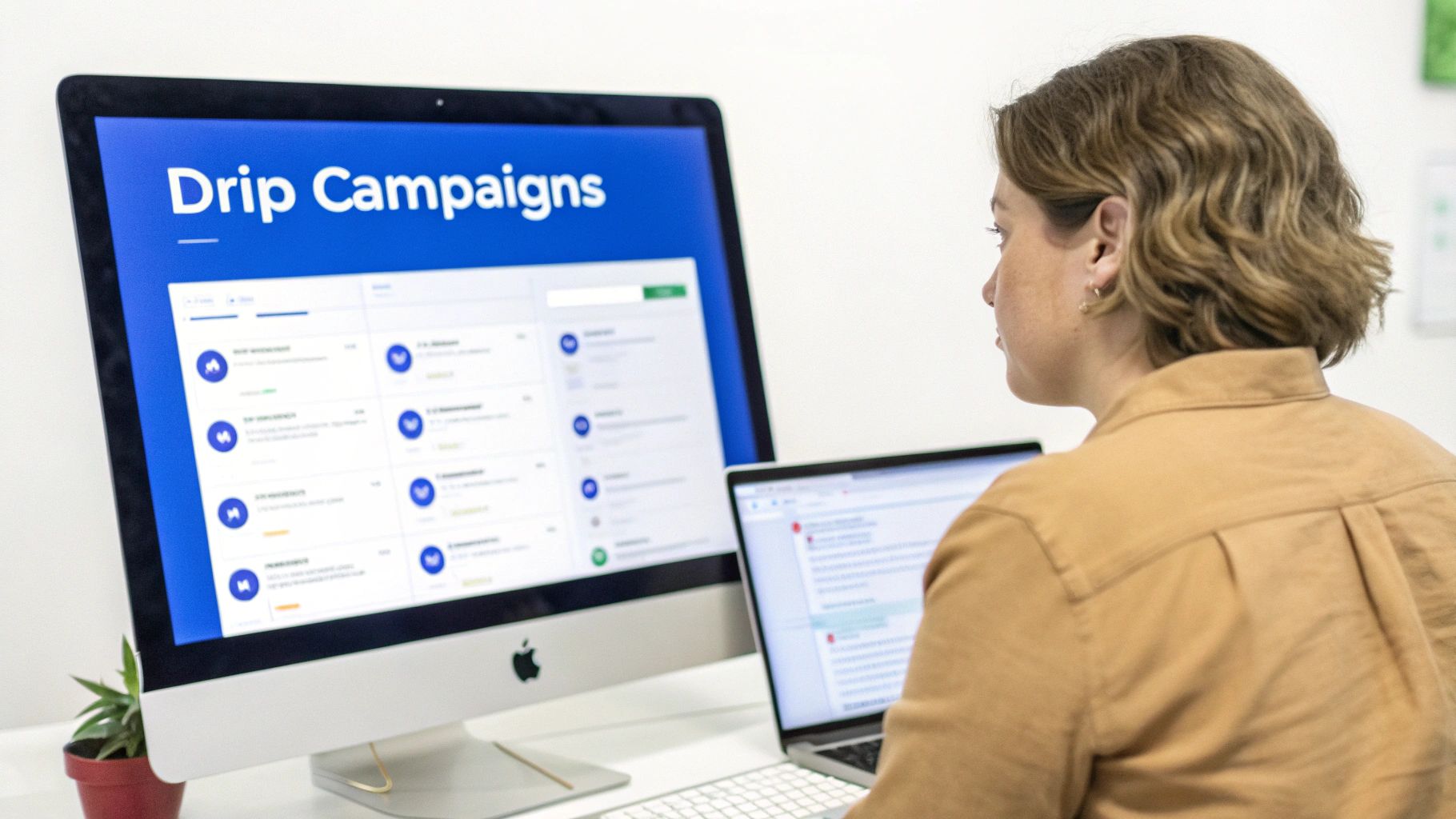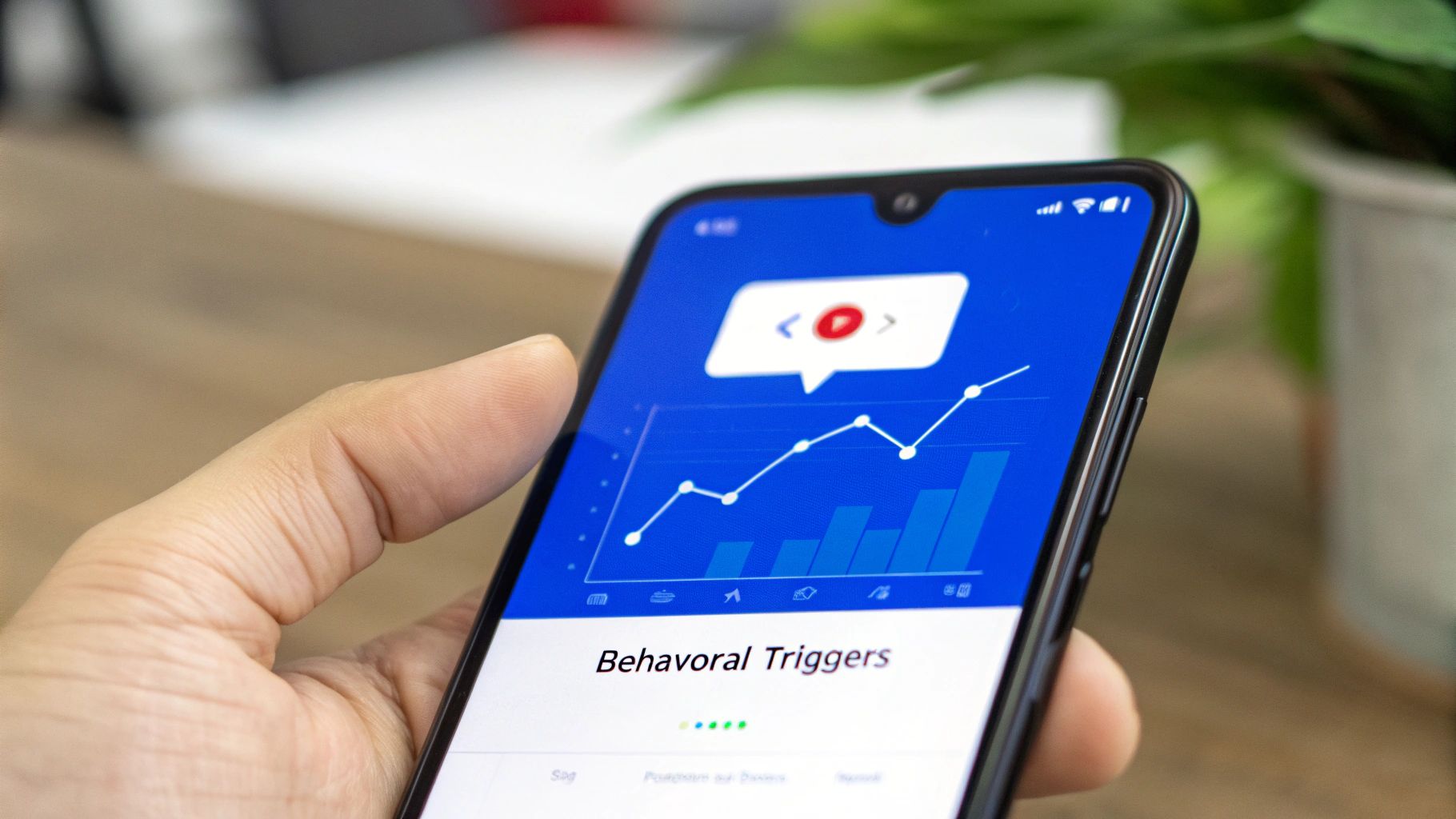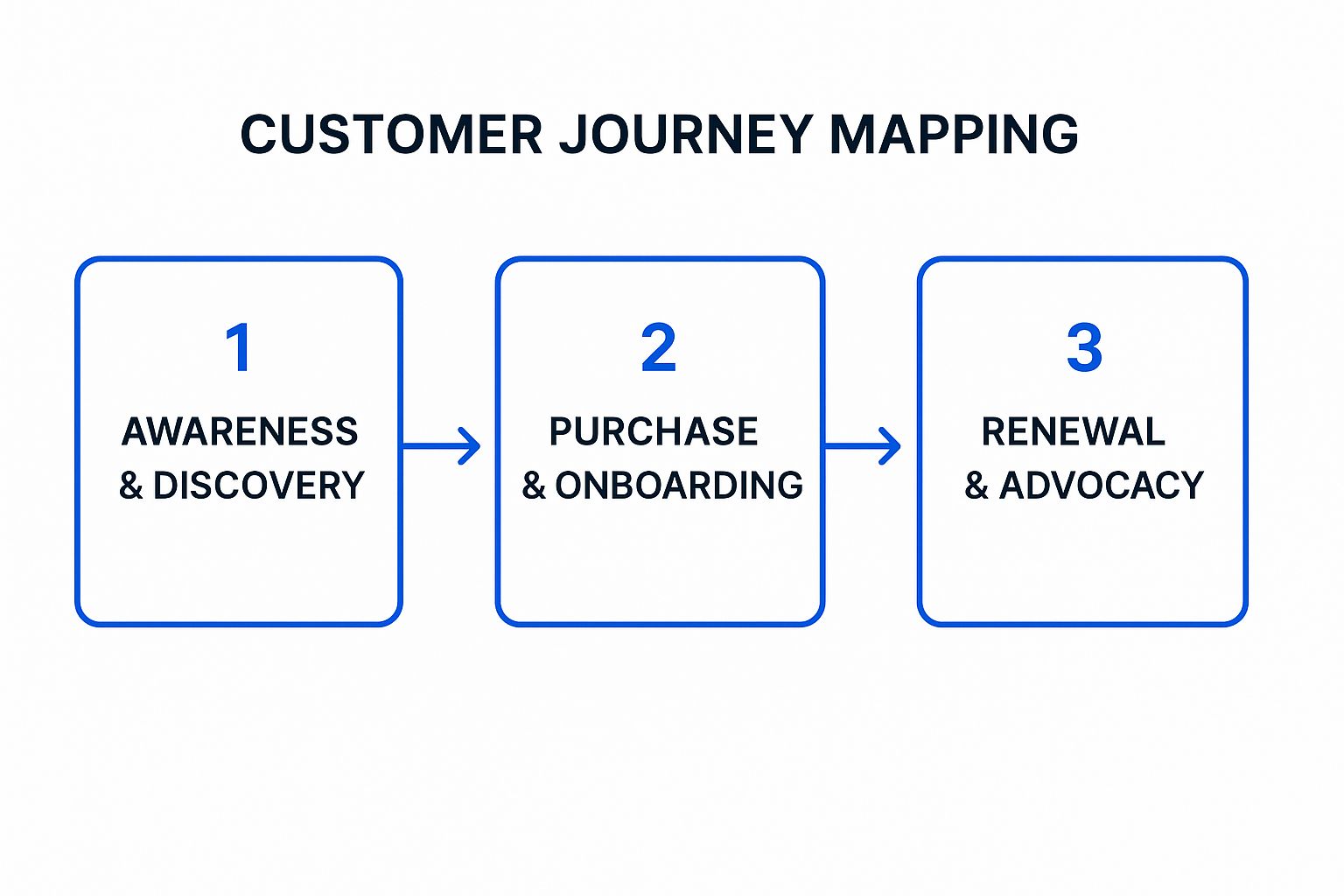Marketing automation is more than just a tool for sending emails automatically. Think of it as your secret weapon for building real, lasting relationships with your customers on a large scale. To get the most out of it, you need a smart plan that goes beyond simple scheduling. A successful strategy is built on a data-driven approach that puts the customer first at every step. Without this, even the best software can fall short, leading to uninterested leads and missed sales.
This guide will give you a clear, actionable roadmap. We’ll cover 9 essential marketing automation best practices that will turn your simple workflows into smart, revenue-generating systems. You'll learn how to improve everything from segmenting your leads to setting up automated triggers and running campaigns across different channels.
Whether you're looking to improve your current setup or start a new strategy from scratch, these tips will help you connect with customers better, align your sales and marketing teams, and achieve real growth. Let's dive into the practical steps that truly make a difference.
1. Lead Scoring and Segmentation
Great marketing is about sending the right message to the right person at the right time. Lead scoring and segmentation are the building blocks that make this happen. Lead scoring is a way to rank potential customers on a scale to see how valuable they are to your business. This score is based on who they are (like their job title or industry) and what they do (like visiting your website or opening an email).
Segmentation then groups your audience into different categories based on this data. This allows you to stop sending generic messages and start delivering personalized content that speaks directly to each group's interests. This targeted method is a cornerstone of modern marketing automation best practices, making sure you focus your energy on the most promising leads.

Actionable Tips for Implementation
- Start Simple and Iterate: Don't make your first scoring model too complicated. Begin by giving points for a few key actions, like requesting a demo (+25 points), visiting your pricing page (+10), or subscribing to a newsletter (+5). Tools like HubSpot and Marketo make it easy to get started.
- Align with Sales: Your scoring system only works if your sales team agrees on what makes a good lead. Talk with them regularly to review the quality of leads you pass along. Adjust your scoring rules based on their feedback and which leads turn into customers.
- Use Negative Scoring: It's just as important to know when someone is losing interest. Use negative scores for actions like unsubscribing from emails (-10) or not engaging for a long time (-5 per month). This helps keep your list of active leads clean and accurate. To dive deeper into optimizing your lead qualification, explore these proven strategies for effective lead scoring best practices.
2. Drip Campaign Optimization
Drip campaigns are a series of automated messages sent to people over a specific period. This marketing automation best practice is perfect for nurturing leads by delivering helpful content that guides them on their buying journey. Instead of a one-off email blast, a drip campaign slowly builds a relationship by providing value at each step, from a welcome email to a follow-up after a purchase.
The best drip campaigns feel personal and helpful, like Spotify's emails to bring back inactive users or Shopify's tutorials for new shop owners. They guide contacts from just being aware of your brand to making a purchase by giving them the right information when they need it most. This makes drip campaigns an essential tool for turning leads into customers and keeping them happy.

Actionable Tips for Implementation
- Use Behavioral Triggers: Don't just send emails based on a set schedule. Trigger your campaigns based on what users do, like viewing a specific product, downloading a guide, or leaving items in their shopping cart. This makes your communication much more relevant. Platforms like ActiveCampaign and ConvertKit are great for setting up these kinds of automations.
- Map to the Buyer's Journey: Create different drip campaigns for each stage of the customer lifecycle. A new subscriber needs educational content, while someone who asked for a demo is ready for case studies and product comparisons. This ensures your messages always match their mindset.
- Monitor and Optimize Engagement: Don't just set up your campaign and forget about it. Keep an eye on the open rates, click-through rates, and conversions for each message. If an email isn't performing well, try a new subject line, call-to-action, or different content. Also, have a plan to automatically stop sending emails to people who don't engage after a few tries.
3. Behavioral Trigger Implementation
Behavioral triggers are automated actions that happen in response to what a customer does—or doesn't do. This powerful practice involves setting up real-time reactions to user activities like visiting a certain webpage, abandoning a shopping cart, or downloading a resource. By sending timely and relevant messages at the exact moment of customer intent, you create a much more responsive and personal experience. This approach is a key part of any successful marketing automation best practices, turning passive observation into active, helpful engagement.

Actionable Tips for Implementation
- Set Appropriate Delays: Timing is everything. An instant cart abandonment email can feel pushy. Try waiting an hour or so to give users a chance to come back on their own. This makes your automation feel helpful, not aggressive.
- Combine Multiple Signals: Make your triggers more accurate by using multiple signals. Instead of sending a message after someone views a single product, combine that with other actions, like how long they spent on the page or if they've bought from that category before. Effective behavioral trigger implementation relies heavily on precise tracking user events across your platforms.
- Create Trigger Hierarchies: Not all actions are equally important. Prioritize high-intent actions, like a "demo request," over lower-intent ones, like reading a blog post. Set up rules so that less important automations are paused if a user takes a more valuable action. This ensures your most critical messages always get through.
4. Customer Journey Mapping and Automation
Understanding the customer journey means mapping out every single interaction a person has with your brand, from their first click to becoming a loyal fan. By creating this map, you can spot key moments and any roadblocks they might face. This is a crucial first step for putting some of the most effective marketing automation best practices into action. Tools like Markopolo make this process far more actionable by helping you visualize and segment different stages of the journey, then align campaigns accordingly—so you’re not just mapping touchpoints, but actively optimizing them.
Automating these journeys ensures every customer gets a consistent, personal, and timely experience at every stage. Instead of random messages, customers receive the right information at the right time, guiding them smoothly from one step to the next. This strategic approach turns your automation from a bunch of separate campaigns into a single, customer-focused system that builds relationships and drives growth. Think of Adobe's guided trials or Starbucks' easy mobile ordering—that's journey automation in action.
The following process flow infographic outlines the three core stages of a typical customer journey, providing a framework for mapping your own automation sequences.

This visualization clarifies how marketing automation can be tailored to support distinct goals at each phase, from attracting new prospects to retaining existing customers.
Actionable Tips for Implementation
- Start with One Persona: Don't try to map every customer's journey all at once. Pick your most important customer type and map their journey first. This makes the task more manageable and gives you a template you can use for other groups later on.
- Use Data, Not Assumptions: Build your map based on real customer data from your CRM, website analytics, and customer feedback. Look at common paths, where people drop off, and where they convert to create an accurate and effective journey.
- Identify Automation Opportunities: While mapping the journey, look for moments where automation can help. This could be sending a welcome email series, starting a cart abandonment workflow, or delivering educational content after a specific action. To learn more about creating these tailored experiences, explore these insights on personalizing customer journeys.
5. Data Integration and Clean Data Practices
Good marketing automation runs on good data. Data integration is the process of connecting all your different systems—like your CRM, website, and social media—to create one complete view of each customer. Without this unified profile, your automation will be based on incomplete or conflicting information, leading to a confusing experience for your customers.
Clean data practices are the ongoing maintenance needed to make sure your data is accurate, complete, and consistent. This means regularly removing duplicate entries, fixing errors, and standardizing how information is formatted. By keeping your data clean, you build a reliable foundation for one of the most important marketing automation best practices. This allows for precise personalization and trustworthy analytics to help you make smarter decisions.
Actionable Tips for Implementation
- Conduct a Full Data Audit: Before you connect anything, map out all your current data sources. Figure out where customer information is stored, what you're collecting, and where there are overlaps or inconsistencies. This audit gives you a clear plan for your integration strategy.
- Establish Data Governance Policies: Create clear rules for how data should be entered and managed across all your teams. This proactive approach stops bad data from getting into your system in the first place, saving you a lot of clean-up work later.
- Implement Regular Data Hygiene Workflows: Set up routine processes to remove duplicates, validate information, and update records. Many automation platforms can help with these tasks, like merging duplicate contacts or flagging incomplete profiles. To ensure your marketing automation runs on a solid foundation, understanding these 8 Data Integration Best Practices for 2025 is a critical next step.
- Use Progressive Profiling: Instead of asking new leads for all their information at once with a long form, collect it gradually over time. Use smart forms that ask for new details with each interaction, building up customer profiles naturally and improving data accuracy. For a deeper dive, explore these expert tips on building a customer database.
6. A/B Testing and Performance Optimization
Guessing is not a strategy. A/B testing, also known as split testing, is how you find out what really works. It involves comparing two versions of something—like an email subject line or a landing page headline—to see which one performs better. This data-driven approach takes the guesswork out of your decisions and allows you to systematically improve every part of your automated campaigns.
By continuously testing and making changes, you can achieve small improvements that add up to big wins in engagement, conversions, and ROI. This commitment to ongoing optimization is a vital part of any advanced marketing automation best practices, ensuring your strategy gets better over time. This technique was famously used in Obama's 2012 campaign, where testing different website elements helped raise an extra $60 million.
Actionable Tips for Implementation
- Test One Variable at a Time: To get clear results, only change one thing between your two versions. For example, test the color of a call-to-action button, but don't change both the color and the headline. If you test too many things at once, you won't know which change made the difference.
- Focus on High-Impact Elements First: Start by testing the things that can have the biggest impact. Focus on email subject lines, call-to-action (CTA) text, send times, and landing page headlines before you worry about smaller details like image placement or font size.
- Ensure Statistical Significance: Don't call a winner too early. Use an A/B testing calculator or the built-in feature in your automation platform (like ActiveCampaign or Mailchimp) to make sure your results are statistically significant. This means the outcome wasn't just due to random chance. For a deeper understanding of how to structure your experiments, you can explore the fundamentals of A/B Testing and Performance Optimization.
7. Mobile-First Automation Design
Most people now read emails and browse websites on their phones, so a mobile-first design is no longer optional—it's essential. This approach means creating all your automated communications, from emails to push notifications, with the mobile user in mind from the very beginning. Instead of designing for a desktop and then trying to shrink it down, you build for the smallest screen first. This ensures your messages are clear, engaging, and easy to use on any device.
This strategy is a key part of modern marketing automation best practices because it lines up with how people actually behave. By optimizing for mobile, you make things easier for your audience, which improves open rates, click-through rates, and conversions. Companies like Starbucks, with its one-click mobile order emails, and Spotify, with its mobile-friendly playlist suggestions, show how effective this can be.
Actionable Tips for Implementation
- Embrace Single-Column Layouts: Design your emails using a single column. This is the best way to make sure your content looks great on all mobile email apps without forcing users to scroll sideways or deal with weird formatting.
- Prioritize Conciseness: Keep your subject lines short (under 30 characters is ideal) so they don't get cut off in mobile previews. The same goes for your email content; get straight to the point to grab attention quickly on a small screen.
- Design for Touch: Make sure all buttons and links are easy to tap with a finger, not a mouse. Buttons should be large enough (at least 44 pixels high) to prevent accidental clicks. Add plenty of space around links and buttons to make them easier to use.
- Test on Real Devices: Previews on your computer are helpful, but they don't show you the real user experience. Use tools like Litmus or Email on Acid to test your automated emails on a wide range of actual mobile devices and operating systems before you launch a campaign.
8. Progressive Profiling and Dynamic Content
Asking for too much information upfront can scare potential leads away. Progressive profiling is a smarter approach that gradually collects customer data over multiple interactions. Instead of one long, intimidating form, you use smart forms that ask for new information each time someone visits. This allows you to slowly build a detailed customer profile without overwhelming them.
This data then powers dynamic content, which automatically customizes your website, landing pages, and marketing messages for each individual. By showing content based on what you already know about a user, you turn a generic message into a relevant, one-to-one conversation. This combination is one of the most powerful marketing automation best practices for boosting engagement and conversions, as it shows you truly understand each customer.
Actionable Tips for Implementation
- Build Your Profile Incrementally: Start by asking for the basics, like a name and email address. On their next visit, use smart forms (a feature in platforms like HubSpot) to ask for more details, like company size, job title, or specific challenges.
- Leverage Implied Data: You can learn a lot about someone without asking directly. Track which pages they visit, what content they download, and how they engage with your emails. Use this behavioral data to understand their interests and needs.
- Create Fallback Content: Make sure everyone has a good experience, even new visitors you don't have much data on. Always have default or "fallback" content ready to display when you can't show a personalized version.
- Maintain Data Transparency: Be open about why you're collecting data and how it will be used to improve their experience. This builds trust and makes people more willing to share information with you. For a deeper look at building these systems, explore how to get started with HubSpot’s smart forms.
9. Cross-Channel Marketing Orchestration
Today's customer journey isn't a straight line—it happens across many different devices and platforms. Cross-channel marketing orchestration is about creating one unified and seamless customer experience by coordinating your messages across all touchpoints, including email, SMS, social media, and in-app notifications. Instead of treating each channel as its own separate island, this approach ensures your brand speaks with a single, consistent voice.
This strategy goes beyond just using multiple channels. It's about true orchestration, where each channel has a specific role and works together with the others. By making this one of your core marketing automation best practices, you can guide customers through a journey that feels personal and connected, which boosts engagement and loyalty. For example, a customer might see a social media ad, get a follow-up email, and then receive a push notification, with each interaction building on the last.
Actionable Tips for Implementation
- Define Channel Roles and Hierarchies: Not every channel is right for every message. Map out your customer journey and decide which channel is best for each step. For example, use social media to build initial awareness, email for detailed nurturing, and SMS for urgent alerts like flash sales or appointment reminders.
- Implement Smart Frequency Capping: Hitting customers with the same message on every channel will quickly lead to them tuning you out. Use your automation platform, like Salesforce Marketing Cloud or Adobe Experience Cloud, to set limits on how many messages a person receives within a certain time frame across all channels.
- Maintain Consistent Branding and Messaging: While the format might change, your core message, tone, and branding should stay the same everywhere. This builds brand recognition and trust. Make sure your visuals and copy are adapted for each channel but are still clearly part of the same campaign.
Marketing Automation Best Practices Comparison
Turning Automation into Your Greatest Asset
Starting with marketing automation is a big step, but true success comes from constantly applying and refining your strategy. The journey from simply using automation tools to building a smart, self-improving marketing machine is built on the best practices we've covered. It's about moving away from mass emails and toward personalized conversations at scale. This helps you build real relationships, drive growth, and create lasting loyalty.
The main idea connecting all these strategies is a change in thinking: from broadcasting to everyone, to having a one-on-one conversation with each customer. Whether you're using lead scoring to find your most interested prospects or behavioral triggers to send timely messages, the goal is always the same. You're using technology to be more human, not less. By mapping the customer journey and creating smooth cross-channel experiences, you make sure every interaction feels connected and valuable.
From Checklist to Strategic Framework
It's important to see these marketing automation best practices not as a one-time to-do list, but as a framework for long-term success. Your efforts in one area will boost your results in another. For example:
- Clean Data and Integration: This is your foundation. Without good, unified data, your segmentation won't be accurate, your personalization will fall flat, and your A/B tests will give you bad information.
- Progressive Profiling and Dynamic Content: These tactics are the payoff for having a solid data foundation. They let you learn more about your customers over time and deliver super-relevant content that they'll love.
- A/B Testing and Optimization: This is how you get better. By constantly testing everything from your subject lines to your call-to-action buttons, you ensure your automated workflows improve with every cycle.
Ultimately, the power of automation isn't just about saving time; it's about creating new opportunities. It frees up your team from doing repetitive tasks so they can focus on strategy, creativity, and building real relationships. By adopting a mobile-first design and carefully optimizing your campaigns, you meet your audience where they are with a message that connects. This commitment turns your automation software from just a tool into your company's most powerful asset for driving revenue and building a brand people love. The key is to start, learn, and never stop improving.







.jpg)
.png)
.jpg)



